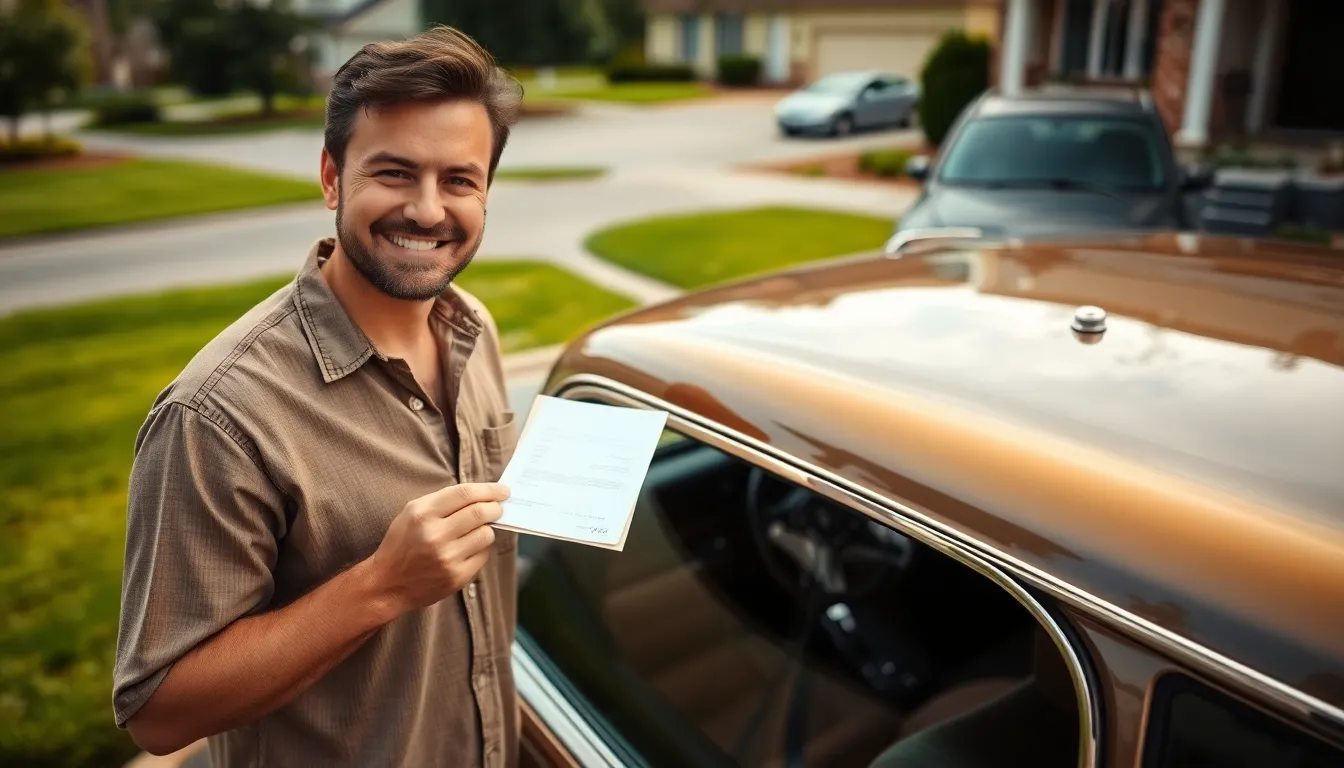Table of Contents
ToggleBuying a used car can feel like a thrilling treasure hunt, but without the right paperwork, it can quickly turn into a wild goose chase. Enter the used car bill of sale—the unsung hero of vehicle transactions. This little piece of paper might not wear a cape, but it’s essential for sealing the deal and keeping everything above board.
Imagine driving off into the sunset with your new ride, only to discover you’ve got more questions than answers about your purchase. A solid bill of sale not only protects both the buyer and seller but also helps avoid any awkward conversations with the DMV. So, buckle up as we dive into why this document is your best friend in the used car world and how to create one that’ll make your transaction smoother than a freshly waxed hood.
Understanding the Used Car Bill of Sale for Car
A used car bill of sale is a vital document in the sale of a secondhand vehicle. This paperwork ensures clarity in the transaction while protecting both parties involved.
Definition and Purpose
A used car bill of sale is a legal document detailing the sale transaction between a buyer and seller. This document includes essential information such as the vehicle identification number, make, model, year, odometer reading, and sale price. Its purpose extends beyond stating the transaction; it serves as proof of ownership transfer. Buyers often require this document to register the vehicle with the DMV, while sellers may need it for tax documentation purposes.
Importance for Buyers and Sellers
Buyers benefit from a bill of sale by securing a record of the transaction. This documentation can help avoid future disputes over ownership or condition. Sellers gain protection against claims of vehicle issues after the sale. By providing a thorough bill of sale, they establish that the car was sold as-is. Protection for both parties remains crucial, especially if problems arise with the vehicle later. Proper documentation minimizes misunderstandings, aiding a smoother transaction overall.
Key Components of a Used Car Bill of Sale for Car

A used car bill of sale includes critical components that detail the transaction. Understanding these elements ensures clarity for both parties involved.
Vehicle Information
Vehicle information provides essential details about the car being sold. This includes the vehicle identification number (VIN), make, model, and year of the car. The odometer reading must show the mileage at the time of sale. Additional features like color or condition may also be noted. Accurate vehicle information helps verify the car’s identity, preventing any disputes arising from misrepresentation.
Buyer and Seller Information
Buyer and seller information establishes the identities of both parties. It lists names, addresses, and contact details for each individual. This section may also request driver’s license numbers to further confirm identities. Having complete and correct data protects both the buyer and seller in case of future issues. This clarity ensures both parties can be easily contacted if necessary after the sale.
Sale Terms and Conditions
Sale terms and conditions outline the specifics of the transaction. This section includes the sale price, payment method, and any applicable deposits. Buyers should note any warranties or guarantees, while sellers may specify any “as-is” statements. Conditions regarding the transfer of ownership and release of liability must also be clear. Clear terms reduce the likelihood of misunderstandings during or after the sale.
Legal Considerations
Understanding legal considerations is essential when dealing with a used car bill of sale. This document plays a crucial role in clarifying responsibilities and rights during a vehicle transaction.
State-Specific Laws
State regulations regarding car sales vary. Many states require a bill of sale to complete the transfer of ownership, while others enforce specific language or clauses. Buyers and sellers should check their state’s requirements to ensure compliance. Including necessary details such as odometer readings and sale dates can also vary by state. Each jurisdiction may have unique forms, which might affect tax implications. Consulting the local Department of Motor Vehicles or legal resources provides clarity on adhering to state laws.
Common Legal Issues
Several legal issues often arise during the sale of used cars. Buyers frequently face problems related to title transfers or undisclosed vehicle issues. Sellers may encounter claims about the vehicle’s condition after the sale. Both parties should specify “as-is” conditions to limit potential disputes. Misrepresentation of the vehicle’s condition can lead to legal challenges for sellers. Ensuring proper documentation helps mitigate these risks. Having clear communication in the bill of sale reduces the likelihood of misunderstandings and promotes a smoother transaction.
How to Create a Used Car Bill of Sale for Car
Creating a used car bill of sale involves several key steps that ensure all necessary information is accurately captured.
Step-by-Step Guide
- Gather Information: Collect the vehicle identification number, make, model, year, and odometer reading. These details provide essential data for the bill of sale.
- Include Seller and Buyer Details: Document full names, addresses, and contact information for both parties. Clear identification helps in minimizing disputes.
- Specify Sale Terms: Clearly state the sale price and terms, including payment method. Including “as-is” conditions protects the seller from future claims regarding vehicle issues.
- Date the Transaction: Add the date of the sale to mark when the transfer of ownership occurs. This timestamp is crucial for record-keeping.
- Sign and Date the Document: Both parties should sign the bill of sale. Signatures validate the agreement and signify acceptance of the terms laid out.
Templates and Resources
Utilizing templates simplifies the process of creating a used car bill of sale.
- Online Templates: Websites like LegalZoom or Rocket Lawyer offer templates tailored to various states. These can help ensure compliance with local laws.
- Printable Forms: State DMV websites often provide printable forms that can serve as a bill of sale. Accessing these ensures adherence to state-specific requirements.
- Sample Bills of Sale: Reviewing examples can clarify necessary details and wording. Understanding common formats aids in crafting an effective document.
- Local Regulations: Researching state laws ensures that the bill of sale contains any required legal language or clauses. Knowing regulations helps prevent future challenges.
- Public Notaries: Considering involving a notary public provides an additional layer of verification for the transaction. Notarization can lend extra legal support in certain circumstances.
A used car bill of sale is an essential document that safeguards both buyers and sellers during a vehicle transaction. It ensures clarity and transparency while providing legal protection against future disputes. By including all necessary details and adhering to state-specific regulations, both parties can navigate the sale process with confidence.
Utilizing templates and understanding local laws can further streamline the creation of this document. With proper documentation in place, buyers can secure their ownership and sellers can protect themselves from potential claims. Overall, investing time in drafting a thorough bill of sale is a smart move that facilitates a hassle-free experience for everyone involved.





